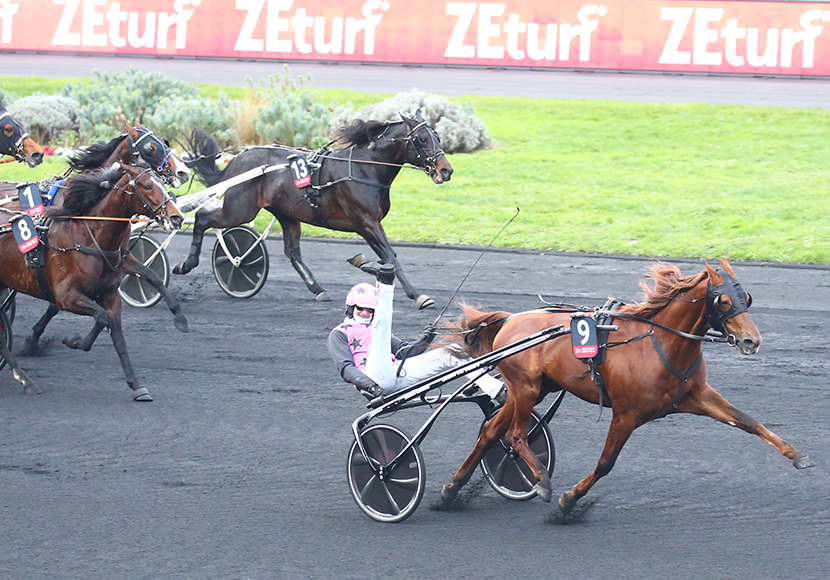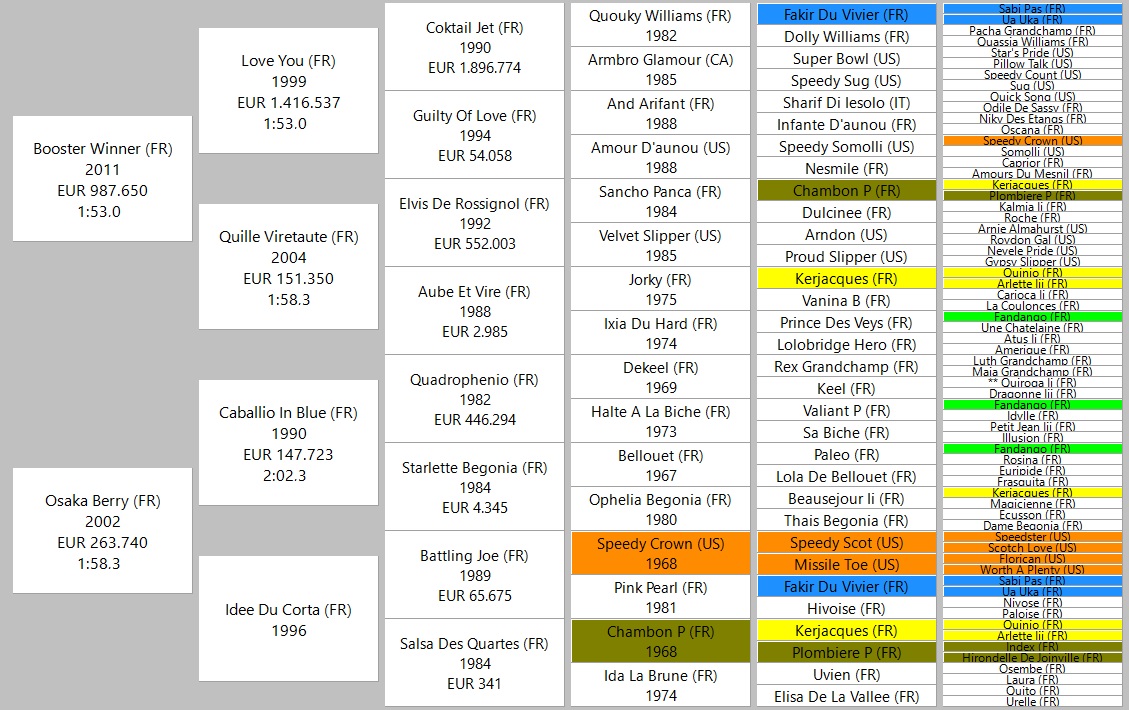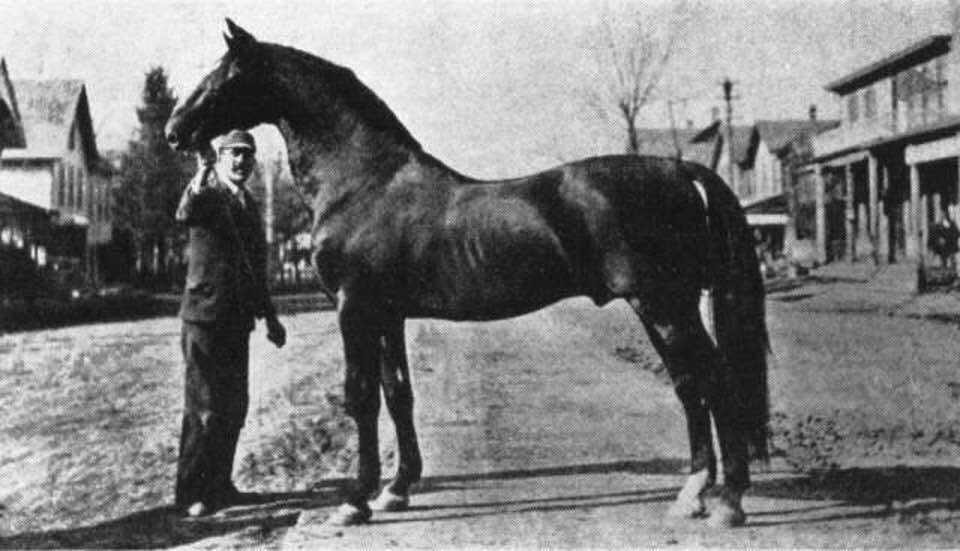The story of Hooker Berry (Booster Winner) is a fascinating one. Had anybody other than breeder Michel Aladenise recognized the talent in the maternal line, there may not have been a Hooker Berry at all.
The story of former car dealer Aladenise’s newest star harness racing trotter begins with Idee du Corta (born 1996), whom he swapped with breeder Bernard Morand for a car when the mare was young. The story could have ended early: Idee du Corta failed to qualify and was eventually bred.

The first born, Hooker Berry’s mother Osaka Berry, was put up for auction as a yearling, but was bought back by Aladenise for 1000 euros (!) Two months later he tried to sell Idee du Corta. With nobody realizing the potential of the mare, she was bought back for 2 000 euros.
Not long after, however, Aladenise received feedback that Osaka Berry was a talented young horse. Selling suddenly became out of the question and the rest is, as they say, history.
Aladenise bought Idee du Corta because of her grandfather. As he says in an interview with Province Courses after the Prix d’Amerique win:
“What I liked about Idée du Corta was that she carried the blood of Speedy Crown as a daughter of Battling Joe. The latter did not really have a good reputation but must have been one of two or three sons of Speedy Crown who was standing in France at the time.
“However, we know how important the opening of the French stud book to the great American stallions of the 1980s and 1990s was, and that is why I was sold on Idee, who was not a very big mare [physically].”
Elite Mares
In hindsight, keeping Idee du Corta proved to be a masterstroke. Osaka Berry (Caballio In Blue, 263,740 euros) started her career with a second-place finish before winning in her second and final start at 2.
The mare wasn’t a superstar but won 14 of 107 lifetime starts. She was prone to breaking, however, and was disqualified in 20 of her races for doing just that.
Then followed Paolo Berry (Camelia du Donjon, 208,090 euros), a talented but injury-prone horse who was particularly good in monte (RUS) races at 3 for Jean-Michel Bazire back in 2006. The highlight was winning the group 2 race Prix Hemine at Vincennes. The third foal from Idee du Corta was the extraordinary Quokine Berry (Chef du Chatelet, €890,580), a fantastic mare who won the group 1 Prix des Centaures in 2008. Quokine Berry won 10 out of 41 races in her career and earned close to 900 000 euros. In fact, six of Idee du Corta’s foals made more than 100,000 euros.
Osaka Berry has followed in her dam’s footsteps. Her first foal Darling Berry (Prince Gede, 304 140 euros) won 12 out of 45 races, most of them at Vincennes. She is herself a broodmare now, giving birth to a colt by Brillantissime last year.
After Darling came Eliska Berry (Rocklyn, 307 145 euros) who won 11 races. The third foal, Falco Berry (Scipion du Goutier, 326 700 euros) was another solid performer, winning 12 races.
The fourth foal, Go On Berry (Oiseau de Feux), qualified but didn’t make any regular starts.
The fifth one, Hooker Berry (Booster Winner, 1,427,520-euros), combines the strength and speed found in his older siblings. Though not a dominant Bold Eagle or Ready Cash, Hooker Berry has one group 1 and seven group 2 wins to his name so far, and at six he’s surely not done with the big races. Just this past Sunday at Vincennes he was 3rd in the 400,000-euro Prix de France Marathon Race, the third leg of the France Triple Crown.
HOOKER BERRY PEDIGREE

What is particularly fascinating with the foals of both Idee du Corta and Osaka Berry, is that they produce well with pretty much any stallion. In fact, some Wanna-Be comedians have even suggested tongue-in-cheek that either mare could probably produce a winner even if bred to a rocking horse.
Aladenise has publicly made it clear he doesn’t believe in inbreeding, and he’s also refrained from jumping on the Ready Cash-bandwagon like so many of his fellow French breeders.
The pedigree of Hooker Berry was inspired by his older sister Eliska Berry. She is by Rocklyn, a son of Love You. Osaka Berry’s sister Tequila Berry has produced the good mare Gloria Berry, by Quaker Jet, another son of Love You. Aladenise thus reasoned there seemed to be an affinity between Love You and the maternal family of “Berry-mares.”
Hence, he picked Love You-son Booster Winner and ended up with this year’s Prix d’Amerique winner.
Were buyers wrong to overlook Idee du Corta and Osaka Berry at those auctions? At the time, there was very little suggesting the genetic potential in the immediate family.
In the nearest generations, the ones buyers look at, there were very few, if any, straws to clutch on to. Had they looked further behind there was plenty of quality to be found – and, as we shall see, Prix d’Amerique history, too. A few rare times, dormant greatness comes alive. However, for the buyers that was such an impossible long-shot not worthy to gamble on.
The dead generations
Idee du Corta’s mother Salsa des Quartes (Chambon P) did not scare anyone on the track. The mare started six times as a three- and four-year-old, but only managed a fourth place at best.
In terms of earnings, it was a meager 341 euros. In the breeding there was also little coming from Salsa des Quartes: out of nine offspring only one started – the 2:05.3 mare Ketty du Corta. The positive thing about Salsa des Quartes was that she was after the champion stallion Chambon P. The latter was French champion stallion for a number of years, following in the footsteps of his sire Kerjacques.
Salsa des Quartes’ mother Ida la Brune was no star on the track, either. Seven finishes in the money, but not a single victory, was the highlight of her career. She produced the 2:00.3-mare Quata des Quartes, who was a capable trotter, but that’s about it. However, Salsa des Quartes is a full sister to the good mare La Gauloise, who was second in the Prix Guy Deloison and Prix Maurice de Gheest in 1980, and also third in the Prix Emmanuel Margouty in 1979.
Ida la Brune’s mother Elisa de la Vallee (Quito) stands with a single win and a 2:20 record as a two-year-old. However, she was bred at three – something not legal in France today – and Ida la Brune was born the following year.
On slower European tracks, 2:20 was a fairly decent time at 2, and Elisa de la Vallee clearly passed on some talent to La Gauloise mentioned above. That there was talent in the maternal line is also shown by Elisa de la Vallee’s one-year-older brother Dilao (Nicias Grandchamp), a stallion who did well in several semi classiques, as the French call it, i.e. what we know as group 2 races, against his peers.
Blue Blood
Elisa de la Vallee is a daughter of Quito, a brother to the French champion stallion Kerjacques and a good sire himself. In breeding, he is guaranteed eternity through his daughter Josubie, mother of the legendary French stallion Viking’s Way.
Elisa’s mother is Urelle, who holds a 2:23,2 record as a three-year-old. She was a small mare, 15 hands according to French information, with a golden pedigree. The sire Le Postillon was himself a good trotter who was second in the Criterium des 5 ans.
However, the stallion drowned in a completely crazy pack of siblings that included big sister Infante II, the first French 1:59 mare, the top stallions Sabi Pas and Hermes D, and not least Jalna IV, mother of the legendary Roquepine, maybe the greatest trotter of all times. Le Postillon, who died just 9-years-old, was the sire of Axius, who won the Prix de France twice.
Urelle’s mother Ops is a blue-blooded daughter of Elope and Chuchundra. The latter is without a record or career data in online databases – something that is completely wrong. Chuchundra is a 2:07-mare (back when that was a very good record) who won six Group-2 races and was second in the Prix de Cornulier in 1952 as a six-year-old. Ops is also a full sister to the top horse Nivose, who won the group 1 Criterium des Jeunes.
That Chuchundra and Nivose became so good is due to the skill of trainer Jan Kruithof (senior) and caretaker Ali Hawas. Chuchundra, who was a large mare at 16,2 hands, was both nervous and sensitive, and struggled with stomach ulcers. Kruithof and Hawas gave the mare cow’s milk as she didn’t tolerate oats.
Under their management, Chuchundra became a very good horse, both with sulky and in monte. A few years later, the duo used their skills on her son Nivose, who was struggling with arthritis and several health problems. According to Jan Kruithof junior, the stallion became dizzy when bending down to graze.
Nivose also makes the pedigree of Idee du Corta a bit special. The stallion is damdamdamsire of Battling Joe, the sire of Idee du Corta. At the same time, Nivose’s full sister Ops is also her grandmother’s great-grandmother. This results in a full-sibling cross. As an added bonus, you actually get two full sibling crosses, in that Le Postillon is found on the maternal side and his full sister Infante II, mother of Sabi Pas, is on the paternal side.
German star
Chuchundra was part of a strong group of siblings. A sister, Boiarina, won several semi-classiques at Vincennes. Another sister, Isadora, only took one win herself, as a three-year-old, but became the mother of the good Rado, who finished third in the group 2-race Prix Pierre Plazen as a three-year-old.
Chuchundra’s mother Quintesse was herself a decent trotter with a record of 2:24.4. Her dam again, Ex-Substance, was a relatively mediocre trotter who regularly competed at Vincennes but without the big results. Ex Substance is via another daughter, Substance, great-grandmother of Nebuleuse MM, fourth in the big monte races Prix des Elites and Prix des Centaures, as well as Leopard, winner of group 2 races.
Ex Substance ended up in Germany towards the end of the Second World War. Whether this was the result of a fair trade or a spoil of war is uncertain, but the latter seems likely. In her new country she had several foals with Calumet Delco, the brilliant US-born trotter who was exported to France in 1930s.
The best, Ejadon born in 1947, became a star trotter for Johannes Frömming and won, among other things, the Åby Stora Pris, the Matadoren-Rennen and the Hunyady race in Austria. He also won several races in Italy and was third in the Elitloppet. The horse has even been elected to the German Hall of Fame.
The Queen
As is apparent, this maternal family was once brimming with top horses. So where does this talent come from? The answer can be found a generation back in the top mare The Substance, born in 1912 in the USA.
The mare was quite good in the US, winning in 2:10.4 at The Red Mile on Oct 5, 1918. Her fastest US time was 2:08 1/2. Clearly a good trotter, The Substance was not ranked among the cream in the country.
The following year she was exported to Belgium and in 1920 the mare dominated Belgian trotting – so much so that she was referred to as the queen of Belgian trotting. In Ostend, she won the Prix de Dixmude despite a 165-meter handicap!
According to the reports, she won in superior fashion in 1.27.6/2515 meters, a mile-rate equivalent of 2:21 over a distance slightly longer than 1,5 miles. In one report it is even stated that the mare could “certainly, if necessary, have trotted 1.25.” (2:16.4) Her winning time was a Belgian record. Later in the year, she lowered this record by two tenths. On slower tracks and over longer distances, this was impressive.
The French took notice. Ahead of the Prix d’Amerique in 1921, The Substance was made the favourite. The trotting newspaper La France Chevaline wrote that “The Substance is the likely winner of the great international race in 1921, because this mare is in top form, as we could judge in training, and we fear that Norbert and Pro Patria are not at their best. As for Passeport, he is a very possible outsider, but it cannot be hidden that the opponents are of the first class.”
As it turned out, the experts were wrong, because Pro Patria was in fact in great form while The Substance was listed second last in the results.
This nevertheless emphasizes the main point, namely that The Substance, despite a somewhat strange name, was a top mare. The Substance was not at home at the Vincennes of old (which was slower, had a steeper hill and was more demanding), however. The mare came back two weeks later for the Prix de Belgique, back then ran after the Prix d’Amerique, with a win the result.
The following winter meeting she returned for the Prix d’Italie, a race that would probably be group 3-today. Again, The Substance proved ineffective at Vincennes, finishing 12th in a race won by the beautiful Greyhound-looking Ogotai Khan.
As an additional note, La France Chevaline wrote toward the end of 1920 that four Belgian horses would try their luck in France at the upcoming winter meeting, including The Substance and Anna Maloney.
Five Prix d’Amerique victories go back to the latter on the maternal line, including Face Time Bourbon. With Hooker Berry, the descendants of The Substance got their first victory in the big race. In any case, it is quite incredible – that two mares imported to Belgium right after the First World War are the origin of six Prix d’Amerique victories. Perhaps “sensational” is more, correct?
The handsomest horse in the world
The Substance is a daughter of the good Bingen-son The Exponent 2:11 3/4 and the mare Red Ant, herself a daughter of St Vincent 2:13 1/2 and Eoka 2:16 3/4. Red Ant was imported to Denmark in 1919 or 1920.
She is 3×4 line-bred on George Wilkes, the legendary breeding stallion who was an alcoholic and refused to eat unless he was given rum and sugar mixed in with his food in his early years. Red Ant had numerous foals in Europe. According to Henrik Berg, one of the most knowledgeable on Danish trotting history, she had foals right up to 1935 – when she was a whopping 33-years-old.
Her dam Eoka, born 1890, has a 2:16 3/4, a good time back when bettering 2:20 was a feat. Her dam Theresa was a full sister to Wilkes Nutwood 2:24 3/4.
Going back to generations one arrives at Ladoga, born 1871. She is a full sister to Mambrino King, born one year later. This became a very important stallion in trotting breeding in the United States, and the cross between the Hambletonian lines and Mambrino King produced many good horses.

At a time when many trotters were coarse, Mambrino King was much more refined in his appearance, and was usually referred to as the “handsomest horse in the world”. This caused him to command a sky-high price at the time, a whopping $10,000, when he was eventually sold to CJ Hamlin.
However, it wasn’t just looks that the Mambrino King passed on to his get, but also speed. Lots of speed. Among other things, Mambrino King became the father of the then lightning-quick Nettie King, in turn the mother of the star The Abbe. He was a pacer who never lost a race and established ultra-dominant stallion lines on the pacing side through Adios and Meadow Skipper.
Mambrino King is also found in the pedigrees of several of the best trotters shortly after the turn of the century, such as Greyhound and Peter Volo.
The Substance and the abundance of top horses many years ago showed the genetic talent in the maternal family. It was almost lost, and nobody wanted to gamble on it coming back.
That is Michel Aladenise’s gain. On Sunday his Hooker Berry was a game third in the $400,000 euro Prix de Paris. Not bad considering nobody wanted to buy the grandam and dam at auction.
by Lisa Harkema, for Harnesslink

 USA
USA Canada
Canada Australia
Australia New Zealand
New Zealand Europe
Europe UK / IRE
UK / IRE



